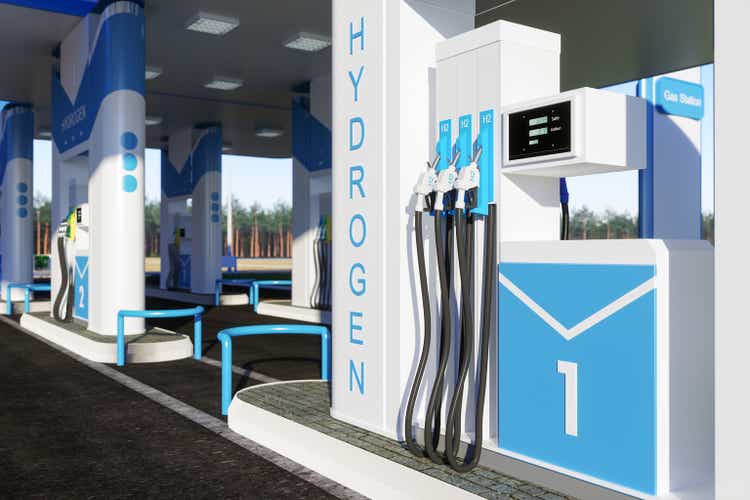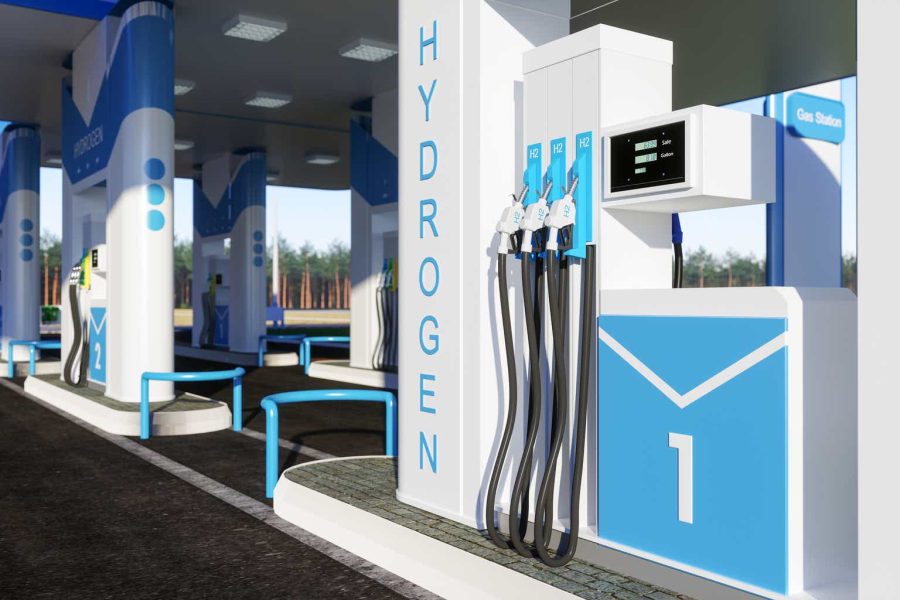Summary:
- With the hydrogen truck sector set for rapid growth and Nikola’s business expanding, I recommend that some risk-tolerant growth investors buy its shares on major pullbacks.
- Despite major risks and the need for additional funds, Nikola’s strong fundamentals suggest that it will have long-term success, with potential for a strong short-covering rally.
- Frost & Sullivan and Bosch predict significant growth for hydrogen-powered trucks, boding well for Nikola.
- Nikola’s performance is improving, with significant orders from AiLO Logistics, Walmart Canada, and a major carrier, indicating strong market acceptance and future revenue potential.

onurdongel
With the hydrogen truck sector poised to grow rapidly going forward and Nikola’s (NASDAQ:NKLA) own business expanding at a fairly impressive rate, I recommend that risk-tolerant growth investors hold the shares and/or buy them on major pullbacks.
Although the truckmaker faces major risks and will have to raise additional funds in the not-too-distant future, I believe that its fundamentals, which I view as strong, will enable it to succeed in the long term. Also noteworthy is that, given the large amount of Nikola’s shares borrowed by short sellers, I believe that there’s a good chance of the stock undergoing a very strong short-covering rally.
Hydrogen Trucks Appear to Have a Fairly Bright Future
At the beginning of this year, research firm Frost & Sullivan reported that the demand for hydrogen-powered trucks, also generally known as fuel cell electric vehicles, was rising. And the firm views “fuel cell trucks {as) a good choice for long-haul transport applications,” while it thinks that these vehicles will also be frequently used to carry heavy objects a long distance.
That’s likely because battery-powered trucks usually can’t travel very far on a single charge or carry very heavy payloads. Finally, Frost and Sullivan believes that hydrogen-powered trucks will be used to haul products that have to be transported quickly. That’s likely because much more time is needed to recharge battery-powered trucks than to refuel hydrogen-powered ones.
The firm predicts that over 3.336 million hydrogen-powered heavy-duty and medium-duty trucks will be in operation in North America by 2035. Further, it estimates that the deliveries of hydrogen-powered heavy-duty and medium-duty trucks will expand at a compound annual growth rate of 55.3% and 40.9%, respectively, between 2025 and 2035.
Perhaps less optimistic but still expecting significant sales and growth for hydrogen-powered trucks is German truck parts maker Bosch. The company predicts that hydrogen-powered vehicles ” will take a 3% share of the global market for newly registered commercial vehicles heavier than six tonnes by 2030, ramping up to 10% by 2035. “
Most semi trucks and many medium trucks weigh more than six tonnes. As a result, I’ll estimate that 75% of the 507,000 commercial trucks sold in the U.S. weigh more than six tonnes, I’ll also conservatively assume that U.S. sales of these trucks will not increase between now and 2035.
With those assumptions and using Bosch’s percentage estimates, about 11,400 hydrogen-powered trucks will be sold in the U.S. in 2030 and roughly 38,000 in 2035. As I’ll note later on in the column, Nikola can generate relatively large amounts of revenue in those years if the sales of hydrogen trucks in the U.S. do indeed reach those levels.
Nikola’s Performance Is Improving and Encouraging
Last quarter, Nikola, which is the only original equipment manufacturer currently building Class 8 hydrogen-powered fuel cell trucks, reported that it had delivered 72 vehicles during the quarter. That enabled it to generate sales of $31.3 million, representing a huge 318% increase versus Q1.
Additionally, on May 21, Nikola announced that AiLO Logistics, a large drayage carrier that operates in the Ports of Los Angeles and Long Beach, had ordered 100 trucks from Nikola. The truckmaker indicated that all of the vehicles would be delivered next year.
What’s more, Nikola indicated that AiLO had purchased 50 trucks in 2024 before making its latest order. This suggests that AiLO is very pleased with the quality of Nikola’s trucks so far. Another marine drayage firms, IMC, also lodged a repeat order with Nikola. Specifically, IMC has ordered a total of 50 of the trucks after initially requesting ten of them.
Moreover, Walmart Canada obtained a hydrogen truck from Nikola. Of course, if Walmart (WMT) is pleased with the truck, it could potentially order hundreds or thousands more such vehicles down the road from Nikola.
Finally, NKLA CEO Steve Girsky reported that an unnamed carrier which has “one of the largest intermodal fleets in North America placed a double-digit order with our dealer network in Q2.” Once again, if the latter company is pleased with Nikola’s truck, it could easily order hundreds more of them.
Estimating Nikola’s Potential 2030 Revenue
Earlier in the article, based on Bosch’s estimate of the proportion of heavy trucks that will be powered by hydrogen and a number of my own assumptions, I suggested that 11,400 such vehicles could be sold in North America in 2030. Each of Nikola’s hydrogen trucks was being sold for $351,000 last year.
If we assume that the sales price of each truck will rise to $400,000 in 2030 and that the company will obtain a 20% share of the market, its revenue would come in at $912 million. This suggests that NKLA stock ,currently changing hands at a market capitalization of $254 million, may be slightly undervalued at this point.
If we use Frost and Sullivan’s estimates, however, NKLA stock looks to be greatly undervalued. As I noted earlier, Frost & Sullivan estimated that “over 3.336 million hydrogen-powered heavy-duty and medium-duty trucks (would) be in operation in North America by 2035.” If we assume that 10% of that number of trucks, 333,600, are sold in 2030 and replicate our earlier assumptions, Nikola’s 2030 revenue would come in at a huge $26.69 billion. In that case, NKLA stock would be hugely undervalued now.
Assessing the Risks Facing NKLA Stock
Nikola’s gross margin was a dismal -175% in Q2, as the price that it’s charging for its trucks is only about 50% of what it costs the firm to make them. Moreover, its operating loss came in at a huge $131 million.
However, as its sales expand, unit economics will boost its gross margins, as it will probably be able to buy parts in bulk at cheaper rates and the workers that it hires to build a relatively small number of trucks each quarter can likely build many more of them at costs that aren’t very much higher. As its gross margins become positive, it can pay for its fixed costs by selling more of its vehicles.
Additionally, as the company sells more emission-free vehicles, it can obtain a sizeable number of regulatory credits that will increase its revenue and reduce its losses. But it’s certainly possible that the company will never become profitable, causing it to eventually go bankrupt. As of the end of Q2, Nikola had just $259 million of cash and short-term investments on its balance sheet, while it burned $95.6 million of cash last quarter. The company raised an estimated $74 million of cash in August by selling up to $160 million of senior notes that can be converted into shares.
Still, the automaker will probably have to raise additional cash within the next few quarters. Given Nikola’s huge potential and the fact that interest rates are dropping, I believe that it will likely be able to raise the necessary funds. But it may not be able to do so, causing it to go bankrupt.
A Potential Short-Selling Rally and the Bottom Line
A huge 27.4% of the shares of Nikola are being borrowed by short sellers. Consequently, if the market becomes less skeptical of loss-making companies as interest rates drop and/or Nikola’s revenue growth accelerates while its gross margin losses decline significantly, Nikola can, I believe, easily undergo a short-covering rally.
Nikola has a first-mover advantage in a new sector that looks poised to grow tremendously over the long term. Additionally, its current valuation is low compared to its potential opportunity. What’s more, its significant growth and progress strongly indicate that its trucks are being well-received by purchasers, and it has established footholds with at least two very large firms that may eventually each purchase hundreds of its vehicles. Finally, it could easily eventually undergo a huge short-covering rally.
On the other hand, with short sellers still in control (the shares are down 35% in the last month alone), they are likely to drop further in the near-to-medium term. Moreover, the company is facing huge risks.
Consequently, I urge those who own the stock to hold it for now and buy more once it hits the $3 level. Risk-tolerant growth investors who are looking for additional exposure to clean transportation and who don’t own the shares should buy a small amount of them if or when they reach $3.
Analyst’s Disclosure: I/we have no stock, option or similar derivative position in any of the companies mentioned, and no plans to initiate any such positions within the next 72 hours. I wrote this article myself, and it expresses my own opinions. I am not receiving compensation for it (other than from Seeking Alpha). I have no business relationship with any company whose stock is mentioned in this article.
Seeking Alpha’s Disclosure: Past performance is no guarantee of future results. No recommendation or advice is being given as to whether any investment is suitable for a particular investor. Any views or opinions expressed above may not reflect those of Seeking Alpha as a whole. Seeking Alpha is not a licensed securities dealer, broker or US investment adviser or investment bank. Our analysts are third party authors that include both professional investors and individual investors who may not be licensed or certified by any institute or regulatory body.
